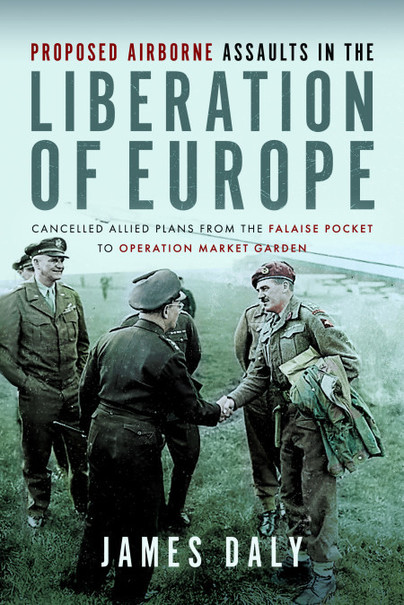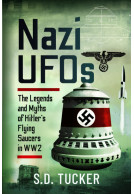Proposed Airborne Assaults in the Liberation of Europe (Hardback)
Cancelled Allied Plans from the Falaise Pocket to Operation Market Garden
(click here for international delivery rates)
Order within the next 4 hours, 2 minutes to get your order processed the next working day!
Need a currency converter? Check XE.com for live rates
| Other formats available - Buy the Hardback and get the eBook for £1.99! | Price |
|---|---|
| Proposed Airborne Assaults in… ePub (3.8 MB) Add to Basket | £6.99 |
The bitter fighting in the so-called Falaise-Argentan Pocket in August 1944, during which the Allies encircled and destroyed a substantial part of Hitler’s forces in northern France following the D-Day landings, marked the last major battle of the Normandy campaign. Despite this, tens of thousands of German soldiers managed to escape through the infamous Falaise Gap.
It was as the Allies continued to pursue the retreating enemy forces that the planners considered or drew-up a number of further airborne operations. As James Daly reveals, three operations, namely Lucky Strike, Transfigure and Axehead, might well have been part of the last of the fighting in the breakout from, Normandy itself. The first of these, Lucky Strike, was intended to see General Montgomery’s 21st Army Group strike to the north-east in the direction of the River Seine, where bridges near Rouen were to be taken by the British 1st Airborne Division.
Transfigure was to be a major operation with the aim of using the First Allied Airborne Army against the French road network with the object of cutting the German lines of retreat across the Seine. Axehead, meanwhile, was a plan to establish an air-head on the eastern bank of the Seine. In this assault the British 1st Airborne Division, along with infantry, Sherman DD amphibious tanks, and specialised engineers, would establish crossings of the Dives, Touques, Risle and Seine rivers.
As the Allies advanced further east into the Low Countries, further Allied airborne assaults were suggested. In Operation Linnet, for example, airborne forces were to capture and hold Tournai on the Escaut river in the western part of German-occupied Belgium. In the event, they were all cancelled, usually as the Allied forces reached the intended dropping zones before the airborne forces could take off. In particular, several of these operations bear very strong resemblance to elements of the Market Garden plan and show early signs of the mistakes. Operation Comet, for example, included a glider coup-de-main for the bridges at Arnhem, Nijmegen and Grave – why did this disappear for Market Garden?
These operations and their planning show that far from being an operation that went wrong in September 1944, the flaws in the Arnhem plan were evident much earlier. They also show that divisions between the Allies emerged much earlier and ran much deeper than originally thought.
“… not only honors the bravery and ingenuity of the men who undertook these perilous missions but also offers valuable insights into the complexities of planning and executing large-scale airborne operations. This is a valuable resource for military historians and aviation enthusiasts alike.”
The Journal of the Air Force Historical Foundation - Spring 2025
"Once again, James deserves great credit for his extensive research and I've no doubt the result will prove of great interest to both historians and those researching on this subject."
HistoryBookChat
Read the full review here
“This book explains the proposals and plans for these airborne support operations… Daly seems to specialize in WWII airborne books…”
Historical Miniatures Gaming Society
Read the full review here
About James Daly
JAMES DALY is a historian and museum curator. James has previously published on the experiences of Portsmouth people in the First and Second world wars. He was inspired to write this series of books on airborne operations by the experiences of his grandfather, who fought at Arnhem with the 11th Battalion Parachute Regiment. Part of the curatorial team that developed the new displays at the D-Day Story in Portsmouth, James has also lectured to a wide range of audiences and appeared on podcasts such as We Have Ways of Making you Talk with Al Murray and James Holland. An Associate Fellow of the Royal Historical Society and an Associate of the Museums Association, James lives and works in Portsmouth, United Kingdom.
Arnhem 1944 The Human Tragedy of the Bridge Too Far (Hardback)
The airborne battle for the bridges across the Rhine at Arnhem ranks amongst the Second World War’s most famous actions – inspiring innumerable books and the star-studded 1977 movie. This book, however, is unique: deeply moved, the author provides a fresh narrative and approach – concentrating on the tragic stories of individual casualties. These men were killed at different junctures in the fighting, often requiring forensic analysis to ascertain their fates. Wider events contextualise the author’s primary focus – effectively ‘resurrecting’ casualties through describing their backgrounds,…
By Dilip Sarkar MBE FRHistS FRAeSClick here to buy both titles for £47.50


















